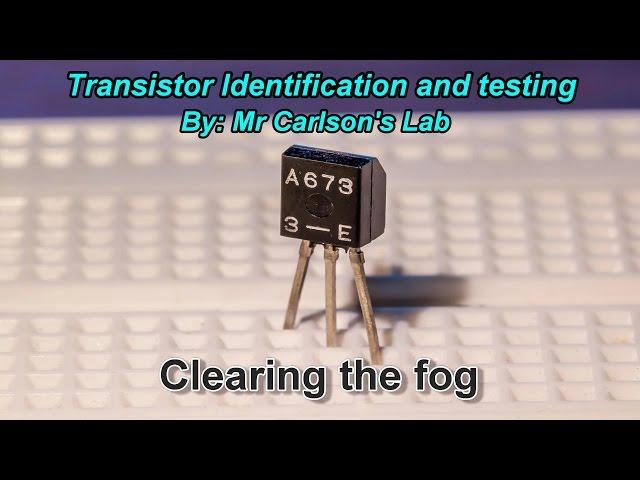
Transistor Identification and Testing made easy.
Комментарии:

It is very much appreciated, please.
Ответить
can it be tested while still in the circuit?
Ответить
What is a diode checker?
Ответить
Left to right with negative on far left I get .556V to middle and .560V to far right. But with negative on far right I also get .673V to middle. Am I right to assume that's the body diode? Also , is this NPN with base on left and which is collector and emitter? I'm a bit confused
Ответить
Very nice video!!! Thank you so much
Ответить
Sir very good explain. thanks
Ответить
Thanks am from great Nigeria. This explanation is so exceptional. Remarkable❤
Ответить
This man has a video resistors color cartoon and made it so simple to understand and I watched others and got nowhere. Thanks Mr Carlson
Ответить
Thank you for the clear and concise explanation!!
Ответить
We learned the schematic symbol as Pointing iN and Not Pointing iN, to distinguish them.
Ответить
I think you remind me a bit of John Carmack.
And maybe I've seen you before, or perhaps someone who resembles you, but I really like your videos!
I think the way that you understand things, and the gifts that God gave you, are very unique and a beautiful thing!
If you didn't know, you were created in the image of God, made by Jesus Christ, Who is the image of the invisible God.
And He loves you so much that He came to live on this Earth and die, in your place, so that you could live and be with Him for eternity in Heaven.
This life on Earth is a chance to come and know Him.
And I hope that you do! (very much so!)
There is none like our Father in Heaven.
God bless you Mr Carlson,

But which leg is the collector and emitter?
Ответить
I've spent one year and a half (since I started self learning electronics) to find the best video on how to test transistors , and I've finally find one , thanks a lot
Ответить
Even after 10 years, you haven't changed. Love it ^^
Ответить
I am living in europe and the 2n system isnt really used much any more since the 70s. The asian 2s system is used here because a lot of electronics come from asia.The rest is the b system.
Ответить
Transistor BC558 PNP UNIJUNCTION TRANSISTOR B1 E B2
Ответить
The link isn't working for me
Ответить
Hi Carlson, I have 2 questions that will be helpful if you present: 1. How to test the C1212A, a silicon NPN transistor with a UCE of 80V and an Ic of 1A. applications: audio frequency stage, power switch and 2. How to test the C3133, a silicon NPN RF power transistor preferred for use in RF power amplifiers in HF mobile radio applications. Can you help out? thanks😀
Ответить
It has disturbing sound Which generated from the marker and white board
Ответить
This is a good video about checking transistors with a meter. However, he did not mention that one failure mode of transistors can be a Emitter to Collector short, so you also need to check across those leads to make sure it is not shorted.
Ответить
Thank You Paul
Ответить
Would love a clean guide when to use a mosfet instead of a transistor
Ответить
This was helpfull
Ответить
this man is a national treasure to be protected at all costs
Ответить
NNN, K...
Ответить
Thanks dad
Ответить
Will the same apply to field effect transistors, thanks.
Ответить
Great explanation of the difference in identification of transistors. Wish I found this video earlier. So used to the jedec 1 2 3n system. Really tedious looking up components in a thick substitution book in the pre- internet days. Great vid here👍
Ответить
Great tutorial! Do you have anything on testing JFETs and MOSFETs?
Ответить
TY
Ответить
think you sir
Ответить
You are a very remarkable person. Now, could you deliver a video how to use an external curve tracer with a digital scope.
Ответить
Thank you for a very good video
Ответить
informative approach . many thanks !
Ответить
Plz check transistor with digital meter
Ответить
Does the unit should be on? Or off? Thks
Ответить
You’re the best, Mr. C. I hope you know how much we appreciate your work. Most generous, helpful, and fun! All the best to you, sir ✌️🎛🤙
Ответить
If you don't have the pin out data,you can determine the transistor leads to which is the EBC by taking notice of diode voltage across the junction. The Emitter - Base junction will always be slightly higher than the Base - Collector junction in bipolar transistors! This is how I determine the leads, when I need to know quickly. It works many times in circuit for a good transistor. I've used this technique for many years! I hope this helps new technicians working in electronics!
Ответить
Thank you!
Ответить
c32725 is PNP transistor
Ответить
Fpga Listen a Tricky measurment Smartphone semiconducters folia
Small Is..

3.52 will excuse dear master but transistor is not two diodes
Ответить
With your knowledge mr Clarkson what or why would a radio volume just go from low to high by its self..
Ответить
This guy has my dream job... He is awesome at what he does and explains it very well... I really miss doing electronic trouble shooting even on my own stuff. Who Knows maybe that since I am retiring I can get a shop setup and do some repair on some old radio's and TVs... If you are new to electronics you want to watch this guy.. If you an old salt like me you will want to watch too. Young or old the man makes it fun and exciting. Something that went away from me after almost 20 years when SOC (systems on a chip) technologies came out.. And pretty much made the art of repairing consumer electronics obsolete with the exception of high end audio and ham gear and others a like. I will say that his working with tubes has sparked my passion as in my education in electronics was split between both tube and solid state devices. My last few years was the death of tube taught theory at least at my particular school. I am very envious of your Tektronix equipment. When working for Western Electric back in the 80s I was assigned a 475B for my use and I absolutely loved that unit.
Great Job... Love your channel...

Thank you.
Ответить
Good evening from Greece, I have seen a lot of videos on the internet, but yours is all the money, the best explanation I have seen, well done, you are a person who has the natural gift to convey what you know correctly.
Ответить
Nice video, thanks for sharing it :)
Ответить
I found a 2SD1047D-E, an NPN in the BCE format. Hmm.
I should say, I placed my positive lead on the base and the negative lead to the collector and then the emitter and I do get a reading of 0.571 on BC and 0.571 on BE. Nice to see both sides as even but how do I know if the value on the meter is too high or low? Doesn't the value matter? This was measured out of circuit.


























